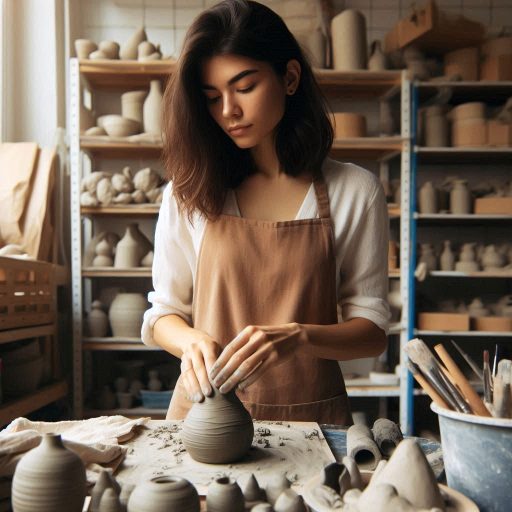Introduction
Galleries play a crucial role for emerging sculptors.
They provide exposure, networking opportunities, and a platform to showcase art.
For many sculptors, galleries are a key stepping stone in their careers.
However, working with galleries presents challenges.
Sculptors often face difficulties in getting noticed, navigating gallery expectations, and securing representation.
These obstacles can make the process seem daunting and overwhelming.
To succeed, emerging sculptors need strategic approaches.
Understanding gallery dynamics, presenting work effectively, and building relationships are essential.
This guide offers practical tips for sculptors to collaborate successfully with galleries.
Researching galleries
How to identify galleries that specialize in sculpture
Finding the right gallery can significantly impact an emerging sculptor’s career.
Start by identifying galleries that specialize in sculpture.
Look for galleries with a history of showcasing sculptural work.
Check their websites and exhibition archives for relevant past shows.
Contact galleries to inquire if they represent sculptors.
This focused approach ensures your work aligns with the gallery’s specialty.
Importance of studying the gallery’s reputation and past exhibitions
Understanding a gallery’s reputation and past exhibitions is crucial.
Research how long the gallery has been in business and its standing in the art world.
Read reviews from artists and critics to gauge its credibility.
Analyze their past exhibitions to see if they align with your artistic style.
A reputable gallery can enhance your visibility and credibility in the art community.
Transform Your Career Today
Unlock a personalized career strategy that drives real results. Get tailored advice and a roadmap designed just for you.
Start NowUtilizing online resources and artist communities to find potential galleries to work with
Online resources and artist communities are valuable tools for finding potential galleries.
Explore online directories and art forums to discover galleries.
Participate in online art communities to get recommendations from fellow artists.
Use social media to follow galleries and stay updated on their calls for artists.
Networking through these platforms can lead you to suitable gallery opportunities.
Combining these strategies will help you identify and approach galleries that best fit your sculptural work.
By doing thorough research and leveraging online tools, you increase your chances of successful gallery representation.
Read: Printmaking in Fashion and Textile Design
Building a Strong Portfolio
Tips for Creating a Cohesive Body of Work to Present to Galleries
Start by defining a clear theme or concept for your portfolio.
Consistency in subject matter or style will make your work more compelling.
Arrange your sculptures to tell a cohesive story or explore a unified idea.
Each piece should complement the others, creating a dialogue between works.
Avoid including unrelated pieces that may dilute the overall impact.
Focus on quality over quantity—select only your strongest pieces.
Review and refine your collection regularly to ensure it aligns with your artistic vision.
Importance of Showcasing a Variety of Styles and Techniques
While cohesion is crucial, showcasing a range of styles and techniques demonstrates your versatility as an artist.
Galleries appreciate artists who can adapt and experiment with different mediums.
Include various techniques, from traditional carving to modern materials, to show your breadth of skill.
Displaying multiple styles also allows you to appeal to a wider audience.
It highlights your ability to innovate and adapt, which can be a deciding factor for gallery representation.
Transform Your Career Today
Unlock a personalized career strategy that drives real results. Get tailored advice and a roadmap designed just for you.
Start NowHow to Highlight Your Unique Artistic Voice in Your Portfolio
Your portfolio should reflect your distinct artistic voice and vision.
Start by selecting works that clearly represent your style and thematic interests.
Write an artist statement that explains your creative process and influences.
Ensure that each piece in your portfolio speaks to your unique perspective.
Use high-quality images and detailed descriptions to enhance your presentation.
Emphasize what sets your work apart, whether it’s your choice of materials, your approach, or your conceptual framework.
Highlighting your individuality will help you stand out to galleries.
By following these tips, you will build a compelling portfolio that effectively represents your artistic vision and increases your chances of gaining gallery representation.
Read: Art Exhibitions: Showcasing Your Sculpture Work
Developing Professional Relationships with Galleries
Building Rapport with Gallery Owners and Staff
Building strong relationships with gallery owners and staff is essential for emerging sculptors.
Start by attending gallery events and exhibitions.
Show genuine interest in the gallery’s mission and the work on display.
Engage in meaningful conversations with gallery staff, and learn about their preferences and needs.
Remember names and follow up with a personalized thank you note or email.
By demonstrating respect and enthusiasm, you establish a positive impression that can lead to future opportunities.
Communicating Effectively and Professionally
Clear and professional communication is crucial when interacting with galleries.
Use concise language in emails and conversations, focusing on relevant details about your work.
Avoid jargon and ensure your message is easily understood.
Respond promptly to inquiries and be courteous in all interactions.
When discussing your work, highlight your achievements and how they align with the gallery’s vision.
Transform Your Career Today
Unlock a personalized career strategy that drives real results. Get tailored advice and a roadmap designed just for you.
Start NowMaintain a professional tone in all correspondence to build trust and credibility.
Negotiating Terms and Agreements with Galleries
Negotiating terms with galleries requires preparation and tact.
Research standard gallery agreements to understand typical terms and conditions.
Clearly outline your expectations regarding exhibition dates, commission rates, and promotional support.
Be open to compromise but know your limits.
Discuss any concerns openly and seek to find mutually beneficial solutions.
Once an agreement is reached, ensure all terms are documented in a written contract.
This protects both parties and clarifies responsibilities.
By focusing on these key areas, emerging sculptors can build strong professional relationships with galleries.
Effective communication, genuine rapport, and clear agreements pave the way for successful collaborations and exhibitions
Read: Interview Tips for Aspiring Sculptors and Designers

Understanding the business side of galleries
As an emerging sculptor, navigating the art world can be a daunting task.
While creating stunning pieces is essential, understanding the business side of galleries is equally crucial for your success.
Here are some tips to help you navigate this aspect of the art world effectively.
Learning about commission rates and pricing strategies
It’s essential to understand that galleries typically take a commission on sales.
The standard commission rate can vary but is usually around 50%.
Pricing your sculptures can be tricky, but it’s essential to account for the gallery’s commission when setting prices.
Ensuring clear communication about sales, payments, and contracts
Maintaining open and transparent communication with gallery owners is key.
Make sure you understand how payments will be processed, what the gallery’s policies are regarding sales, and have a clear contract outlining the terms of your relationship.
Being aware of gallery policies and expectations
Each gallery operates differently, so it’s crucial to familiarize yourself with their policies and expectations.
Transform Your Career Today
Unlock a personalized career strategy that drives real results. Get tailored advice and a roadmap designed just for you.
Start NowSome galleries may require exclusivity, while others may allow you to work with multiple galleries.
Understanding these expectations will help you avoid misunderstandings.
In essence, working with galleries as an emerging sculptor requires a balance of artistic talent and business acumen.
By understanding commission rates, pricing strategies, maintaining clear communication, and being aware of gallery policies, you can set yourself up for success in the art world.
Remember, collaboration with galleries can be a mutually beneficial relationship, so approach it with professionalism and a positive attitude.
Read: Printmaking Inspirations: Nature and Landscape
Creating a strong online presence
Importance of a professional artist website and social media presence
Having a professional artist website is crucial for emerging sculptors looking to establish their presence in the art world.
Your website serves as a digital portfolio where galleries, collectors, and art enthusiasts can explore your work, learn about your artistic practice, and contact you for potential collaborations or purchases.
Additionally, maintaining a strong social media presence is equally important.
Platforms like Instagram, Facebook, and Twitter enable you to reach a wider audience and showcase your work to a global community.
By regularly posting updates, behind-the-scenes content, and engaging with your followers, you can generate interest in your sculptures and attract the attention of galleries seeking new artists to represent.
Showcasing your work online to attract the attention of galleries
When it comes to showcasing your work online, quality matters more than quantity.
Select a curated selection of your best sculptures and present them in high-resolution images on your website and social media profiles.
Provide detailed descriptions of each piece, including materials used, dimensions, and inspiration behind the artwork.
To increase your chances of getting noticed by galleries, consider creating a separate portfolio section on your website that highlights your most recent projects or exhibitions.
Include testimonials from satisfied clients or reviews from art critics to build credibility and demonstrate your professionalism as a sculptor.
Utilizing online platforms to connect with collectors and art enthusiasts
In addition to attracting galleries, online platforms offer a unique opportunity to connect directly with collectors and art enthusiasts who may be interested in purchasing your sculptures or collaborating with you on future projects.
Engage with your audience by responding to comments, hosting live Q&A sessions, or sharing behind-the-scenes videos of your creative process.
You can also leverage e-commerce features on your website to sell your sculptures directly to customers or participate in online art marketplaces to reach a broader audience.
Collaborating with influencers or partnering with art-related brands can further expand your reach and increase visibility among potential buyers.
Transform Your Career Today
Unlock a personalized career strategy that drives real results. Get tailored advice and a roadmap designed just for you.
Start NowBy actively networking and engaging with the online community, you can build a loyal following and establish yourself as a reputable sculptor in the industry.
Participating in gallery exhibitions and events
Benefits of participating in group shows and solo exhibitions
Participating in group shows allows emerging sculptors to showcase their work alongside other artists, gaining exposure and recognition.
Solo exhibitions provide the opportunity to display a cohesive body of work, allowing for a deeper exploration of themes and concepts.
Networking opportunities at gallery openings and art events
Gallery openings and art events are great opportunities for emerging sculptors to network with art collectors, curators, and other artists.
Building relationships in the art world can lead to collaborations, commissions, and future exhibition opportunities.
How to prepare for gallery exhibitions and promote your work effectively
Ensure your sculptures are ready for display by completing any necessary finishing touches and packaging them securely for transportation.
Prepare a professional artist statement and biography that clearly articulate your artistic vision and background.
Create a portfolio of high-quality images of your sculptures for promotional materials and online platforms.
Utilize social media and networking platforms to promote your upcoming exhibition and engage with potential viewers.
Attend gallery events and make connections with curators and collectors to expand your audience and reach.
By actively participating in gallery exhibitions and events, emerging sculptors can gain valuable exposure, network with industry professionals, and promote their work effectively to a wider audience.
Conclusion
Working with galleries can be a transformative experience for emerging sculptors.
To recap, start by understanding each gallery’s focus and aesthetic.
Tailor your portfolio to align with their vision and demonstrate how your work complements their existing collection.
Approach galleries professionally, presenting a well-organized portfolio and a compelling artist statement.
Network actively within the art community to make connections and find opportunities.
Be open to feedback and willing to adapt your approach based on gallery input.
Perseverance is crucial in the art world.
The path to success is often long and filled with challenges.
Keep refining your craft, applying to different galleries, and seeking feedback.
Transform Your Career Today
Unlock a personalized career strategy that drives real results. Get tailored advice and a roadmap designed just for you.
Start NowEach experience, whether successful or not, offers valuable lessons and growth.
Stay committed to your artistic vision and continue to push boundaries with your work. Opportunities will arise as you persist in your efforts.
Building strong relationships with galleries is vital for long-term success.
Cultivate connections by staying engaged and communicating regularly.
Show appreciation for their support and be reliable in meeting deadlines and commitments.
Strong relationships can lead to more exhibition opportunities, increased visibility, and valuable industry connections.
By fostering these relationships, you create a network of support that can significantly impact your career.
Working with galleries requires a strategic approach, perseverance, and relationship-building.
Embrace each opportunity as a chance to grow and showcase your art.
By following these tips, you will enhance your chances of success and establish a lasting presence in the art world.




